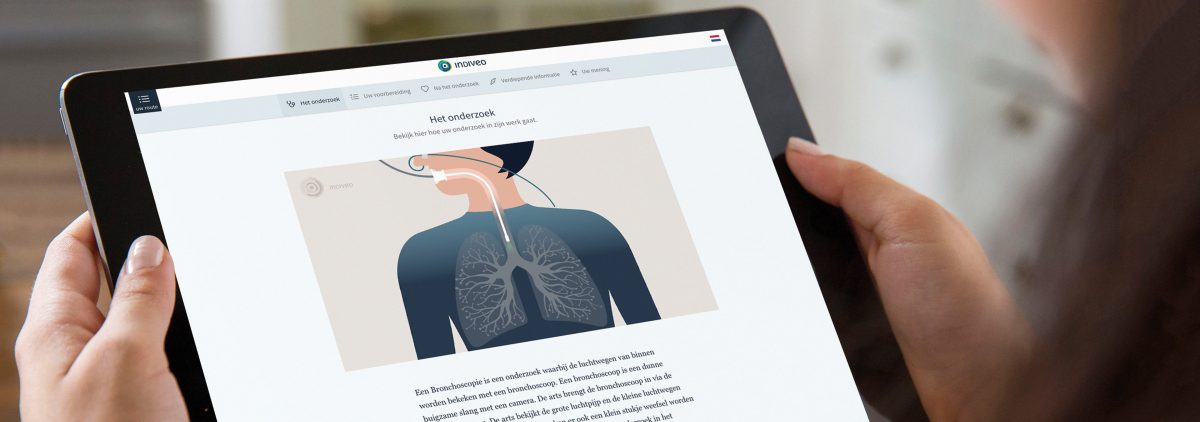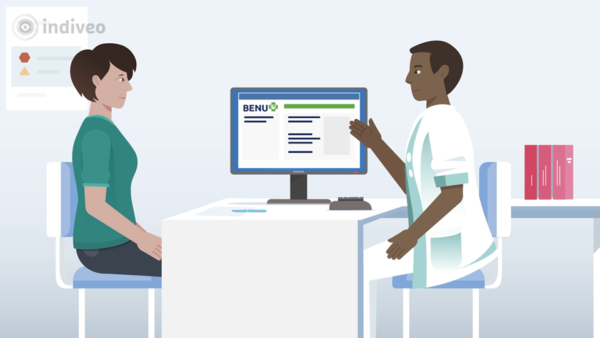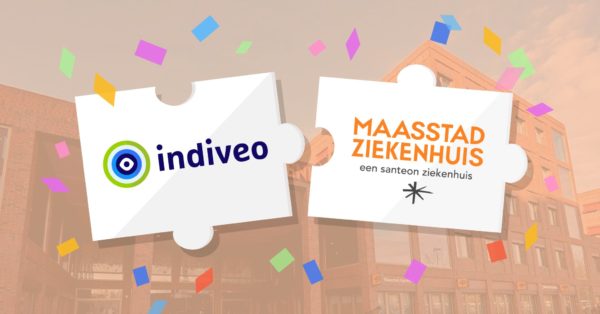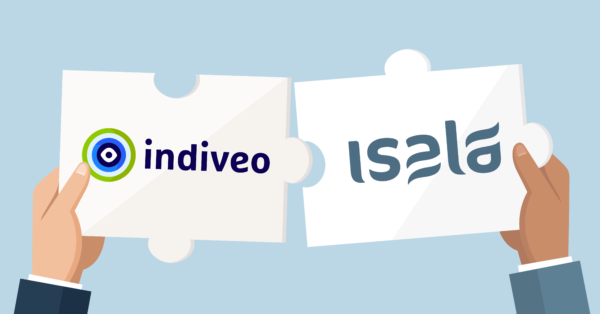Written by Ralph Koppers - Reading Time: 7 minutes
This article was posted in Pulmoscript in September 2017 .
How Indiveo came about, a brief history
Do you ever take pictures with your smartphone? Do you send them to friends or share them on social media? Why do we do it? Images say so much more than words.

The above was reason for us to take a critical look at the way we (health care providers) inform our patients about upcoming research, about diseases and treatments. Hospitals inform patients largely with textual leaflets, containing lots of words. In addition, healthcare providers usually give a verbal explanation. Visual material is used only to a limited extent.
And yet we live in a world of images! Web shops do not offer an item that does not have images to accompany it. The popularity of Facebook, Snapchat and Instagram is unprecedented. There is no hotel on the Internet that presents itself without pictures. We know very well that images make a lasting impression and convey information better than text. Fortunately, research also confirms this.(1)
The project we started
With this insight and the knowledge that the current way of informing patients is insufficient (2), two years ago we submitted a subsidy application to the Innovation Fund of De Friesland Zorgverzekeraar (DFZ) for the project: 'Indiveo: patient information in image and sound'. The Maatschap Friese Longartsen supported our application and there was willingness to gain experience through a pilot in all Frisian hospitals. After approval of our project, the starting shot was fired!
What is Indiveo?
Indiveo is a smart tool that consists of an interface for healthcare providers that allows visual information to be sent digitally to patients, as well as a digital environment for patients where the information can be viewed on a smartphone, tablet, laptop or PC. Because all diagnostic procedures available to the pulmonologist are explained in an animation, a verbal explanation of how, for example, a bronchoscopy is done, from A to Z, is no longer necessary. Through this visual explanation, patients arrive at their examination better prepared.
Patient and caregiver experiences
The project is now as good as completed, so we are happy to share our experiences. First of all, thanks to the innovation fund of DFZ for the subsidy. Without organizations that are committed to innovation in this way, our project would not have gotten off the ground.
Patients
During the pilot period, more than 6,000 lung patients in 4 Frisian hospitals were educated about upcoming research with visual information. Because patients can give feedback through the system, we know that patients appreciate this new way. On average, they rate the information with 4 out of 5 stars ('an 8').
Do you feel informed with Indiveo?
Yes
Not quite
Of this group indicated:
38% Wanting more animations
28% Want more contact with the doctor
6% Wanting more in-depth information
28% To indicate some other reason
We also get a lot of reactions from patients. A wonderful response via a secretary from the Nij Smellinghe Hospital in Drachten: "Someone even called today (to the outpatient clinic) to say she thought it was great that we sent this (information about bronchoscopy via Indiveo), now she was not so afraid anymore."
Uniform information in different hospitals
What we found particularly exciting was whether it would be possible to use the developed uniform information in multiple hospitals. We reviewed all 40 animations (the common pulmonary diagnostics) in the 4 different hospitals before the start of the pilot with the responsible content expert healthcare providers. We asked them to view the visual information "through the eyes of the patient. In this way we wanted to investigate whether there were substantial and patient-relevant differences between the way the diagnostics are performed in the different houses.
Without exception, all the pulmonologists and nurses involved were perfectly capable of looking at the information in this way. In terms of content, there appeared to be hardly any differences between the hospitals. Differences relevant to the patient were then adjusted in the animation.
Good, unambiguous information, often based on national standards, can therefore be used in different hospitals, allowing our patients to benefit from uniform, visual information. As a side effect, at the level of hospital organizations, joint use of information can reduce costs.
Use among caregivers
During the design process, much time was spent on usability and design. Through multiple rounds of design and testing, the interface for caregivers was created. Indiveo is a plug-and-play tool that anyone can use immediately, without training.
We have noticed that caregivers have many ideas about new applications within Indiveo and further development of the system. The involvement of the users is fantastic and motivating!
Patiënten informeren kan er anders uit gaan zien
Meerdere studies tonen aan dat patiënten de verstrekte informatie van de zorgverlener maar beperkt (< 50%) kunnen reproduceren.(2) De helft van de tijd die wij besteden aan uitleggen kan daarom praktisch als verloren worden beschouwd. Door patiënten digitaal én in begrijpelijk beeld te informeren wordt deze informatie overdracht veel beter. Dit heeft niet alleen te maken met het feit dat beeldende informatie bij de individuele patiënt beter beklijft (1) maar zeker ook met het feit dat informatie váker (alleen of met naasten) én in een eigen tempo, (opnieuw) bekeken kan worden.
If information is correctly (read: medically correct and understandable to patients) converted to images, all patients can benefit. By offering information in this way, 30% of the total consultation time can be gained.(3) 'Sensible Care' (4) right down to earth!
Putting the importance of the doctor-patient relationship first
Shaping informing in this way does not necessarily mean more distance between you and the patient. By "gaining" consultation time, we do not mean that this time can be eliminated. On the contrary, Indiveo creates more space for personal attention (3) and shared decision making, for example.
Furthermore, through patient feedback we learn what patients really care about! Patients can be asked all kinds of questions through the system (for example: "did you feel safe during the bronchoscopy?" or "were the staff at the outpatient clinic friendly?"), but also PROMs and PREMs (5) can be included. This makes Indiveo a tool for practical implementation of, for example, Value Based Healthcare.(6) In this way we can learn together from patients and thus improve our care!(7)

Completion of the project; the start of the sequel!
We can be proud of the result we achieved together! We are now closing the pilot period and will continue with great enthusiasm, including the integration of Indiveo in the various EPDs and of course expanding the number of animations (syndromes, treatments and other specialties). Of course, we hope that all (lung) patients in the Netherlands may be informed in a good, visual way. Lung physicians, united within the NVALT, could contribute to this. It would distinguish us as a specialty and scientific association if we could work together in this way to provide uniform and high-quality patient information.
References:
1 - Ms. C.S. Meppelink: Designing Digital Health Information in a Health Literacy Context. ISBN: 978-94-028-0119-4
2 - NTvG. 2003;147:1238 Kievits et al.
3 - NTvPC 2010;1:22 Keulers et al
4 - Sensible Care: https://www.zorginstituutnederland.nl
5 - Patient Reported Outcome Measurement/Patient Reported Experience Measurement.
6 - Redefining health care: Creating value-based competition on outcomes Porter and Teisberg 2006
7 - Vision document Medical Specialist 2025



